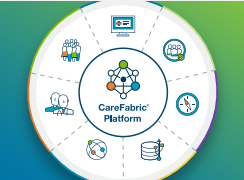Recently I sat down with Jen Gray, Director of Consulting, and a special team from RethinkFirst. If you haven’t heard, our organizations have partnered to integrate ABA workflows for autism and IDD services. This will have lasting impact on the market and be a game-changer for care providers.
How will this collaboration revolutionize the industry? Read more to find out.
Autism: An increasing challenge
There’s a growing demand for ABA and behavior tracking services. That’s because autism is rising to the forefront of policy reform, market and industry trends. As Jen Gray mentioned: “Since 2000 there has been a 317% increase in children diagnosed with autism. In the last year alone, there has been a 22% increase.”
Jen went on to explain some reasons for this sharp increase in prevalence. Increased awareness of autism and policy reform has undoubtedly contributed to its rise in prevalence. In addition, recent studies have focused on AAPI, Latinx and Black children, not just white. In other words, these shifts may reflect “screening, awareness, and access to services among historically underserved groups,” according to Jen. While this is great news for children who need treatment, it points to numbers that always existed. Autism is a bigger challenge than any of us realized.
“One possible explanation for the rising prevalence of autism is improved diagnostic criteria and increased awareness among healthcare professionals,” Jen continued. “In the past, many individuals with autism may have been misdiagnosed or just overlooked altogether. However, with advancements in medical knowledge and a greater understanding of autism spectrum disorders, more accurate diagnoses are being made.”
And with more accurate diagnoses come more demand for services.
This brings us to autism insurance reform, a crucial step toward equal opportunity for individuals with an autism spectrum disorder (ASD). As of today, all fifty states have taken action to require meaningful coverage for the treatment of autism in state regulated health plans. This mandate also requires insurance companies to provide coverage for individuals with an autism diagnosis.
Although the required degree of coverage varies by state, these reforms seek to address the financial burden faced by families seeking necessary treatment for their loved ones. It allows them to access early intervention programs, behavioral therapies, and speech and occupational therapies. “By mandating coverage for evidence-based treatments and promoting early intervention services, we can ensure that every individual has an opportunity to reach their full potential, regardless of their neurodevelopmental differences,” Jen said.
The case for integrated care and Autism/IDD workflows
What many people don’t know is that 95% of individuals with autism have co-existing physical and behavioral health challenges––an average of five or more. Individuals with autism have four times as many prescriptions written than the general population: 53% have sleep disorders and 40% have anxiety and mood disorders.
When you look at the numbers, you begin to see why integrated care is so critical. Your organization, for example, probably provides more than just autism services––whether that’s IDD, child and family or behavioral health. If so, you know that autism and IDD have entirely different workflows from, say, behavioral health. They require different documentation, unique care plans, specific reporting and billing requirements.
Care providers can do so much more with one platform, which allows them to view each individual holistically and with a focus on enhancing quality of life. You should expect your IT vendor to provide a single platform to meet all these workflows––today, and as you grow in the future. Using a single platform will also help you attract and retain staff, which we all know is difficult in the current market. BCBAs and RBTs are posting record numbers of turnover, due in no small part to things like “documentation overload.” Having one, integrated platform addresses this burden, and ensures that staff spend time providing care––which they enjoy––rather than clicking around on a piece of technology that isn’t intuitive or simple.
So, how can we create an intuitive user experience that serves your team, the autism and IDD community, and your mission?
The addition of ABA workflows with our EHRs gives you a comprehensive view of each individual's care in one platform. Streamlined data collection and data analysis lead to increased time providing care. You can also improve clinical outcomes with more than 1,500+customizable e-lessons, plans, goals and embedded video-based trainings. With this new platform, you have the ability to schedule, get signatures, and interact with parents and caregivers in the portal. Plus you can access a 40-hour RBT certification and CE events to help your team meet certification requirements. And, it's clinically backed by a scientific leadership and advisory board––which means that you can be sure that all of your documentation is clinically sound and appropriate for the individuals that you're serving.
How the platform works
Jamie Pagliaro is the EVP, Chief Learning Officer and co-founder of Rethink. He’s worked in autism care for more than 25 years, founding the first charter school in the U.S. dedicated exclusively to children with autism.
“We started Rethink as a way to better disseminate research-based practices for supporting individuals with autism,” Jamie said. “We wanted to leverage technology to reach more families, providers and caregivers.”
Research-based means that Rethink solutions are peer-reviewed by board of advisors, with a focus on clinical best standards. Let’s dive deeper into RethinkBH ABA from a clinical programming perspective, including evidence-based treatment plans, data collection, certified training for providers, parents and caregivers, and mobile functionality.
Clinical programming
Upon login, BCBAs are taken to an assessment area. This includes a range of tools, from early developmental skills checklists to the VB-MAPP for assessing developmental levels. Providers can also access Rethink’s proprietary medical necessity assessment. This algorithm helps clinicians determine an appropriate level of care or dosage of treatment for a child based on their unique clinical profile.
After the assessment, clinicians proceed to the treatment planning library, where they can find an extensive set of resources to help them construct an individualized treatment plan. If your organization uses the VB-MAPP, the workflow will generate suggested treatment goals for that child's plan. The treatment planning library is fully customizable, so clinicians can create their own programs for individuals with unique needs. Afterwards, they can upload content to share with other care team members.
Detailed written instructions and a video model show parents and caregivers or RBTs how to implement the teaching strategy outlined in the protocol. Research shows that these videos significantly improve fidelity when staff and parents carry out the treatment protocol.
Data-driven care
While treatment is being delivered, data is collected. Teams can see all data in real time through automated graphing. And when it comes time for reassessment or reevaluation, they can automatically generate reports that embed those graphs and provide summaries of exactly what the individual worked on.
Ongoing education and training for better care outcomes
In addition to the parent/caregiver training videos, the solution offers a forty-hour training course for becoming a RBT. BCBAs can also enhance their knowledge with continuing education, including expert webinars, printable materials and standard protocols.
For RBTs or BCBAs making home visits or on-the-go, mobility is critical. The mobile app allows all required documentation for reimbursement to occur at the point of care, with or without an internet connection. This eliminates administrative burden and allows the care team to focus on the needs of the individual they’re serving.
The Rethink/Netsmart partnership
With the growing need for autism care and providers, access to the highest quality interventions––and the greatest efficiency––are a must. At Netsmart, we focus on the importance of using a single platform to care for the whole person. With high-risk populations, it’s crucial to leverage data and care coordination to close gaps in care and reach as many people as possible.
ABA workflows provide the data, the evidence-based treatment and training, and the workflow efficiencies your clinical team will love.
As Jamie Pagliaro said: “Our overarching goal is to support our partners in improving clinical outcomes, improve operational efficiency, and use the limited resources we all have to best meet the needs of our clients.” He added: “And wherever possible, to create automation in their workflows.”








